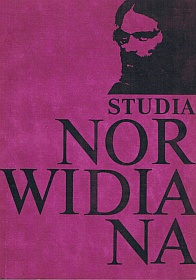Uwagi o listach Cypriana Norwida
Abstrakt
The author does not approach Norwid’s letters as a source of information about the writer and his time or in their function as document and commentary but tries instead to identify their features when regarded as a message parallel to literature in the strict sense. Norwid’s correspondence is an outstanding literary work; yet dealing with it as literature one has to take into account the special features of the letter as a genre originally designed for a practical purpose. The author describes Norwid’s letters from the point of view of (1) the writer himself, (2) the aims served by the letter and (3) the addressee. As regards the first angle, the author’s interest concentrates on the self-creating procedures employed by Norwid to evoke the desired image of the “epistolary self”, and on that self’s social roles. Norwid’s private life plays a minor role in his letters. They are intellectualized and marked by a tendency towards objectivism and generalization; hence the distinct nature of the self-creating procedures, which tend to be concealed in superindividual postulates and diagnoses. Norwid’s self-creation consists in attempts to explain his lack of success as due to the shortcomings of the social reality and in representing himself as the exemplar of realization of the postulated values. Norwid aims at identifying the common good with his individual interest: in striving to attain his private goals he considers them in terms of general needs (struggle for one’s own is a struggle for the universal; struggle for the public is a struggle for one’s own). Characteristic of Norwid’s letters is his position as an outsider, resulting from the distinctness of both his models and the manner of their realization and from mutual rejection.
With regard to the second set of problems, five major groups of goals and tasks are distinguished: (a) goals related to the circumstances of the writer’s life, (b) goals related to the circumstances of other people’s lives, (c) tasks consisting in influencing the addressee so as to effect particular convictions, attitudes or actions on his part, (d) theoretical goals connected with the intellectual apprehension of reality, (e) self-creative purposes. The various ends are achieved by a very rich inventory of means that largely determines the high literary value of the letters.
As regards the third point, the main finding concerns the relative unimportance of the individuality of the addressee for the character of the letter. Dependence on the addressee's personality is practically limited to the superficial level. Norwid adapts his letters not so much to the addressee’s personality as to his own axiological image of him constructed on the basis of his own ethical and social postulates and the requirements of self-creation. Norwid often wrote to different people about the same things, in the same way and even in the same words. The striving for objectivism in the presentation of the subject-matter overshadows other considerations. Once Norwid is sure that he has found the right expression for what he wanted to say, he sees no need for change in a letter to another person. This small dependence of the letters on the addressees is a characteristic trait of Norwid’s correspondence, one that together with reticence about his private life sets it clearly apart from the letters of the romantics, especially those of Zygmunt Krasiński. A classification of the letters according to the addressees would be of little use (the information value of such an exercise would be close to null). The most profitable approach would be to describe them with a regard for the social role of the addressee, his attitude to Norwid (i.e., the writer’s work and system of values) and his role as determined by the practical goals of the letter, for it is these factors that are reflected in the form of the letters. For example, a letter to a particular individual may be a letter to a Pole, a Christian, a publisher, a person emotionally neutral to Norwid. It is stated in conclusion that a reader who is not their addressee can read Norwid's letters as something like a novel, analogous to the fully fictional epistolary novel, a novel about the experiences and reactions of a thinking man in an unkind world.
Copyright (c) 1985-1986 Studia Norwidiana

Utwór dostępny jest na licencji Creative Commons Uznanie autorstwa – Użycie niekomercyjne – Bez utworów zależnych 4.0 Międzynarodowe.





